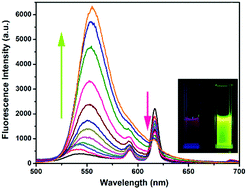An RGH–MOF as a naked eye colorimetric fluorescent sensor for picric acid recognition†
Abstract
Lanthanide metal–organic frameworks (MOFs) are considered as promising sensing materials in picric acid (PA) detection. Designing and preparing fluorescence enhancement sensors, however, are challenges due to the electron deficient properties of PA. Multifunctional MOF materials with guest dyes introduced into host MOFs have aroused great interest for various applications recently. Herein a ratiometric fluorescent sensor (denoted as RGH–Eu(BTC)) for PA recognition was developed by immobilizing a rhodamine derivative (RGH) onto the surface of lanthanide MOFs (Eu(BTC)). In the presence of acidic PA, the fluorescence of red emission was quenched by the donor–acceptor electron transfer process and green emission was caused by the spirolactam ring-opening of rhodamine. In addition, the color of the sensor system was changed from colorless to orange, which could be distinguished easily by the naked eye. RGH–Eu(BTC) also demonstrated high selectivity toward PA among nitroaromatic compounds and organic carboxylic acids in solution. This work established a very promising strategy for the simple, accurate and instantaneous sensing of PA in practical applications.



 Please wait while we load your content...
Please wait while we load your content...